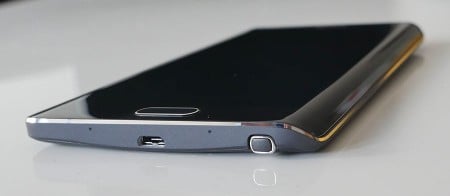Phones are getting thinner, but the people making them are also getting more experimental, and that’s something we’re seeing in Samsung’s Galaxy Note Edge, a take on the phablet that makes the screen wrap all the way to the edge.
Features
Samsung’s second Note for the year, it’s time to see what life is like on the edge as a phone is made with a screen that gets startlingly close to the edge of the phone.
The screen and concept are very unique, and the idea really has never been seen in Australia, with a 5.6 inch display that wraps around one side of the phone, pushing past the right edge and providing a different panel to use along the corner edge. Samsung’s screen in this instance is a 5.6 inch Super AMOLED screen running a resolution of 2560×1600, with Corning’s scratch-resistant Gorilla Glass 3 protecting the display.
Under this is all of the technology that makes a phone tick, with the Qualcomm quad-core Snapdragon 805 processor clocked at 2.7GHz, Adreno 420 graphics chip, 3GB RAM, 32GB storage, and a microSD slot to expand the latter of these when needed.
Google’s Android 4.4 “KitKat” runs on the Galaxy Note Edge out of the box, equipped with Samsung’s TouchWiz overlay ready for action.
Connections on the Note Edge are pretty standard for a flagship phone, with 802.11a/b/g/n/ac WiFi, Bluetooth 4.1 with Low Energy and A2DP, Near-Field Communication (NFC), infrared, GPS, and of course 4G LTE which in this phone supports both Category 4 and Category 6 LTE, though you’ll need a telco supporting either the Cat4 150Mbps or Cat6 300Mbps speeds to get download speeds like them.
A microUSB port is also included, found at the bottom, while a 3.5mm headset jack is up at the top.
Cameras are of course included, with the rear camera set to 16 megapixels with a flash and support for 4K Ultra HD video capture, while the front-facing camera is set to 3.7 megapixels and can capture videos in self-portraiture at roughly the same resolution of the screen, shooting at 1440p or 2560×1440.
Samsung’s Note-friendly S-Pen also makes an appearance, catering for note taking, image and screen crops, as well as drawing and other things that are rolled out over time through apps found on the Google Play and Samsung app marketplaces.
Buttons are pretty much the same as other Samsung phones, with a power button up top and a volume rocker on the left edge, while the rest of the buttons sit below the screen including a multitask soft button and back soft button flanking a physical home button.
You’ll also find a fingerprint sensor here, found under that very same home button.
Samsung’s rear cover is removable, and under it, you’ll find a microSD slot, microSIM slot, and a battery which is rated for 3000mAh.
Why an “edge”?
When Samsung calls this version of the Galaxy Note the “Edge,” what the company actually means is that the screen curves on one side in a way that it practically meets the edge of the handset, different to how other phones generally let their screens stop near the frame at the top, but not to the point where they would meet the table.
But “what” the edge is isn’t as important a question as “why” an edge, so why do we want an edge, and what problems does this seek to address?
Rather than solve something, a woe with smartphones if you will, the Edge looks to have come out of Samsung’s research with curved displays, something we saw at CES earlier in the year when Samsung’s own curved screen faced off against LG’s concepts.
Back then, the two companies started dabbling in curved LCD technology to make screens more foldable and drop resistant, because if a phone with a curved screen can flex a little when it hits a surface, there’s a stronger chance it won’t break.
Interestingly, Samsung and LG went in opposite directions on this one, with Samsung opting for a curve that arched on the phone’s shortest side, making it a curved portrait phone, while LG made the arch on the longest side, essentially affording it more form to adopt to a leg in a pocket, or, heaven forbid, a butt cheek and not crack.
Australia never saw Samsung’s effort in this area (we reviewed the LG G Flex, however), but what we did hear about it told us that while the phone wasn’t necessarily a huge success, it gave Samsung some research to work with, especially since the phone could rock from side to side, which gave Samsung a clock that could pop up in one side based on that one very unique gesture.
How does this relate to the Edge?
Samsung’s clock concept is back in this phone, appearing on that “edge” of a curved screen, though the screen isn’t plastic like it has been on previous curved efforts. Rather, there’s Gorilla Glass protecting it, though we hope the curve gives the display some wiggle room if the phone unfortunately meets something hard.













